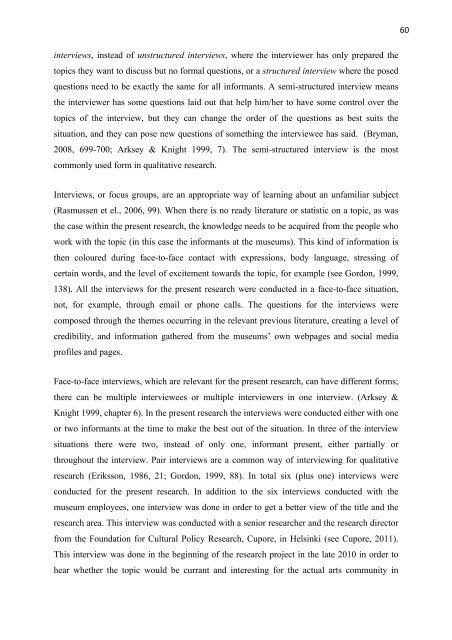Is there more to it than posting a status update?
Is there more to it than posting a status update?
Is there more to it than posting a status update?
Create successful ePaper yourself
Turn your PDF publications into a flip-book with our unique Google optimized e-Paper software.
interviews, instead of unstructured interviews, where the interviewer has only prepared the<br />
<strong>to</strong>pics they want <strong>to</strong> discuss but no formal questions, or a structured interview where the posed<br />
questions need <strong>to</strong> be exactly the same for all informants. A semi-structured interview means<br />
the interviewer has some questions laid out that help him/her <strong>to</strong> have some control over the<br />
<strong>to</strong>pics of the interview, but they can change the order of the questions as best su<strong>it</strong>s the<br />
s<strong>it</strong>uation, and they can pose new questions of something the interviewee has said. (Bryman,<br />
2008, 699-700; Arksey & Knight 1999, 7). The semi-structured interview is the most<br />
commonly used form in qual<strong>it</strong>ative research.<br />
Interviews, or focus groups, are an appropriate way of learning about an unfamiliar subject<br />
(Rasmussen et el., 2006, 99). When <strong>there</strong> is no ready l<strong>it</strong>erature or statistic on a <strong>to</strong>pic, as was<br />
the case w<strong>it</strong>hin the present research, the knowledge needs <strong>to</strong> be acquired from the people who<br />
work w<strong>it</strong>h the <strong>to</strong>pic (in this case the informants at the museums). This kind of information is<br />
then coloured during face-<strong>to</strong>-face contact w<strong>it</strong>h expressions, body language, stressing of<br />
certain words, and the level of exc<strong>it</strong>ement <strong>to</strong>wards the <strong>to</strong>pic, for example (see Gordon, 1999,<br />
138). All the interviews for the present research were conducted in a face-<strong>to</strong>-face s<strong>it</strong>uation,<br />
not, for example, through email or phone calls. The questions for the interviews were<br />
composed through the themes occurring in the relevant previous l<strong>it</strong>erature, creating a level of<br />
credibil<strong>it</strong>y, and information ga<strong>there</strong>d from the museums’ own webpages and social media<br />
profiles and pages.<br />
Face-<strong>to</strong>-face interviews, which are relevant for the present research, can have different forms;<br />
<strong>there</strong> can be multiple interviewees or multiple interviewers in one interview. (Arksey &<br />
Knight 1999, chapter 6). In the present research the interviews were conducted e<strong>it</strong>her w<strong>it</strong>h one<br />
or two informants at the time <strong>to</strong> make the best out of the s<strong>it</strong>uation. In three of the interview<br />
s<strong>it</strong>uations <strong>there</strong> were two, instead of only one, informant present, e<strong>it</strong>her partially or<br />
throughout the interview. Pair interviews are a common way of interviewing for qual<strong>it</strong>ative<br />
research (Eriksson, 1986, 21; Gordon, 1999, 88). In <strong>to</strong>tal six (plus one) interviews were<br />
conducted for the present research. In add<strong>it</strong>ion <strong>to</strong> the six interviews conducted w<strong>it</strong>h the<br />
museum employees, one interview was done in order <strong>to</strong> get a better view of the t<strong>it</strong>le and the<br />
research area. This interview was conducted w<strong>it</strong>h a senior researcher and the research direc<strong>to</strong>r<br />
from the Foundation for Cultural Policy Research, Cupore, in Helsinki (see Cupore, 2011).<br />
This interview was done in the beginning of the research project in the late 2010 in order <strong>to</strong><br />
hear whether the <strong>to</strong>pic would be currant and interesting for the actual arts commun<strong>it</strong>y in<br />
60















